The tongue "big sister" ...
Author:Institute of Physics of the Ch Time:2022.09.03
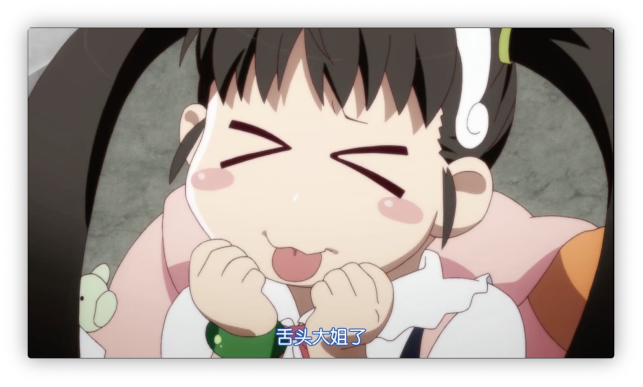
Ah Garbage Jun can't understand the cuteness of the tongue of Miss Bayi Temple. It's okay. We must not only say that the tongue knot is very cute and high -level, but even we can play flowers.
Senior statement of tongue knot
In order to give the "tongue tongue knot", the language I lost was suddenly awakened by that little skin. I turned to find my own Chinese knowledge and brought you a table for you to "tie the tongue":
Voice (word)
various:
In the words of the classical Chinese, the voices. Such as: the famous mountains, put them into the water, seek themselves, and put it into action.
Source: Education Encyclopedia
By the way, that's it, that is the thing called the sound! (That thing that made me read in ancient texts.)
And similar pronunciations and other interesting words: "嫑" (biáo, that is, "don't"), "覅" (fiào, still don't), etc. It seems that everyone refuses to be very simple. (If you still want to know more, you can refer to Zhihu: What are the interesting pronunciation characters, or go through the books in ancient Chinese.
Instead
Cut the sound:
Two Chinese characters are combined into a Chinese character phonetic, which is a traditional phonetic method in Chinese history.
Source: Education Encyclopedia
Since there are two (or above) characters in front that can synthesize a new word, so similar, why not remove one word into two characters? (What a deep Chinese Chinese character ... What a bleak Chinese test ...)
This is an ancient way to note the text. Although writing "X, AB anti" at the beginning, with the development of history, in order to avoid the homophonic "rebellion", it gradually became "x, ab cut" or "x, AB turning". When you see the "X, AB cut" in the ancient books, you only need to put the "A" mother and "B" vowel (half containing the media, that is, the "i" in the "i" in "liáng" Sound.) Combining the tone, you can get the pronunciation of "X". (Reference materials: China Encyclopedia)
A simple example: in "Kangxi Dictionary":
Liang: "Tang Yun", "Ji Yun", "Yunhui" Liang, Lu Zhanghe, Yinliang. "Zheng Yun" is cool and cool. "Rhyme" Bo Han is cool. "Qianhan · Five Elements" is cool, winter kills. "Note" Division ancient said: Liang, Bo also.
Note 1: If there is a word that cannot be displayed ... that should be a rare word that the current font is not supported, I am not able to show it here, so I am embarrassed.
Note 2: In cutting sounds, ancient sounds are generally used instead of modern pronunciation. So sometimes it is not very easy to understand.
Phonetic
Submix:
China ’s first legal Chinese character -style pinyin letter during the Republic of China. Also known as Guo Yin letters, phonetic symbols.
Source: China Encyclopedia
The cut sound above is really overwhelmed -after all, the cutting sound is a bit like a text fun game, not enough (one word can have multiple cutting ways), and it is not modern (after all, many words are many words. Pronunciation has gradually evolved in the development of history, let alone "different" dialects "in a street in my hometown). So the phonetic symbol appeared, using specific characters to represent the response syllable:
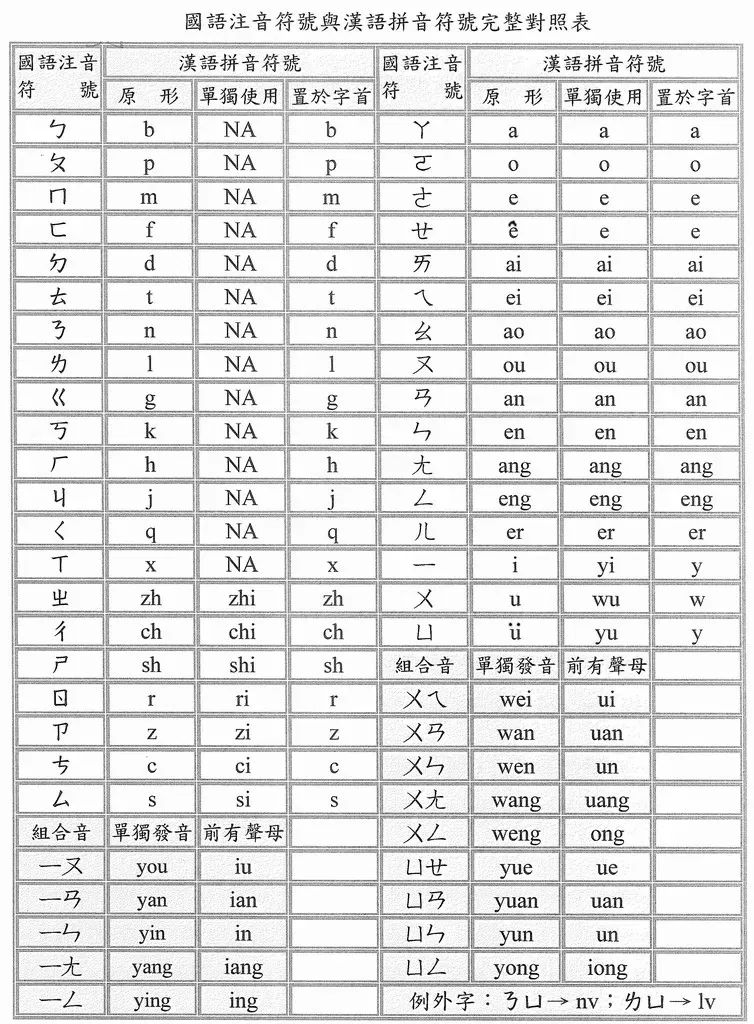
Pictures from the Internet
At this time, the note is very similar to the modern pinyin. It is combined with some syllables, and then the corresponding sound can be emitted according to the specific rhythm and tone. Although this set of phonetic methods is rare, Taiwan Province is still in use, and it can be seen in some Chinese dictionaries.
It seems that at the time of mastering a "tongue knot" technology
So do you not want to master a cheat for creating sound?
Sound is a kind of "swing"
As we all know, as long as you sway at a certain frequency, you will form a sound.
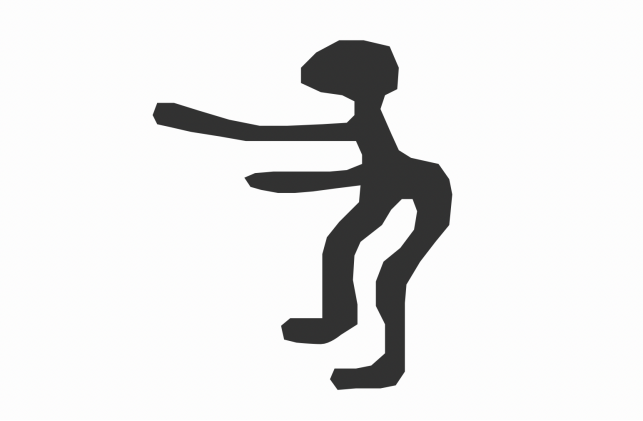
The picture comes from Wikipedia. This novelty is not very familiar and feels fun.
If we use the degree of swaying -for example, the amplitude of the twisting boy above as the vertical axis, and use the horizontal axis as time, draw on the paper, (a simple) form is likely to be like the picture below:

The above pictures are drawn by Mathematica
So when we "swayed", we had a vibration -at the same time there was a sound.
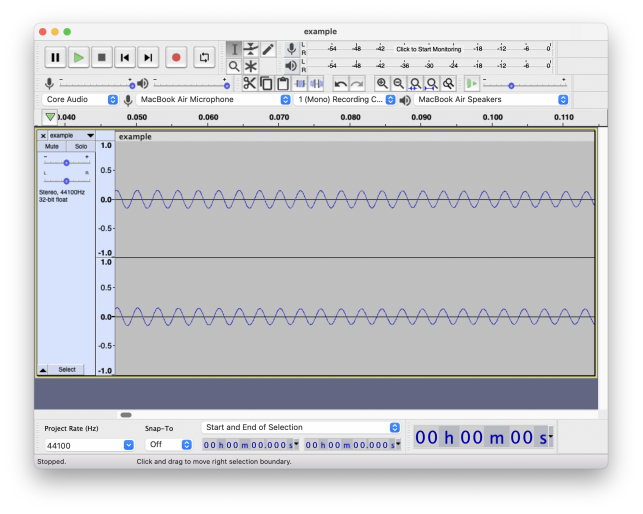
The above is viewed by AudaCity. The audio is generated by GarageBand with a tone of 80 ’sin synth. According to the big guy, it is FA, which is 4 of the notation.
The swing frequency of different objects is not equal, and each object will have its own "inherent frequency". Taking a piano with a piano with a tone (440Hz above the central C) as an example, the frequency of Central C is about 261Hz.
Of course, the sounds we hear are not all pure single -frequency sounds. In reality, if you press a set of keys at the same time, you will get a mixed sound -the estimation of learning music will say this is called chord.
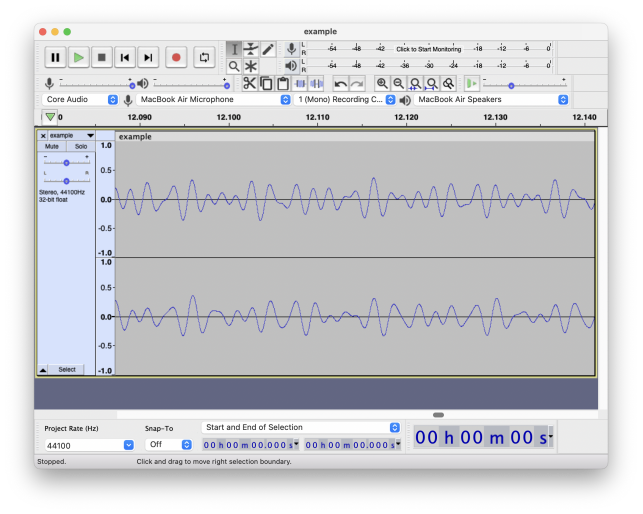
The above is viewed by AudaCity. The audio is generated by GarageBand with a tone of 80 ’sin synth. String according to GarageBand display should be DM.
Therefore, the sound of impure frequency is not a sound that is not needed. Just like the chords in the music, this kind of sound of multiple monochriors can give people a harmonious feeling. Similarly, when we knock on the piano keys in the center of the piano, the sound of the piano is not only a pure 261Hz sound, but a sound with other frequencies -then this sound forms a special piano -like sound tone Essence This seems to be the same sentence, the same pronunciation, but different people have different tones to read.
So, the simple resonance is mixed together
Although the previous phonetic, cutting sounds, and the common pinyin, when you listen), are more like a mixing of a piece of sound into several syllables. Then spell it like a patchwork, like the following:
To some extent, the above operation is equivalent to cutting a piece of audio in time and chopping it carefully. But my small Chinese primary school has to change the direction "cut" -Since we all know, the sound is just a simple vibration synthesis. So why not think in turn -can the sound break down the sound into some simple vibration? As if what should be said in order, but because of his tongue knot, he spit it out.

At this time, a gentleman named Fourier said: No problem. Functions that meet certain conditions can always be expressed into a linear combination of triangle function. Place the function in a functional space based on the triangular function system.
The picture comes from Wikipedia Encyclopedia
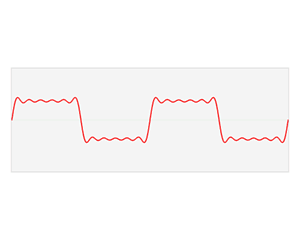
So we can transform the vibration sound into a combination of frequency -as if the big guys who learn music, we can know the scores through listening -we now have a theoretical tool that can change the sound to the frequency spectrum.
This kind of demand is also very obvious -if I go to learn the musical instrument and let me sway according to the waveform chart, I always feel a bit difficult, and if it is played by the score (like our spectrum), then at least It will be simpler and intuitive. For example, the following sound is an example:
The picture comes from the GarageBand screenshot, and the notes are blindly pressed.
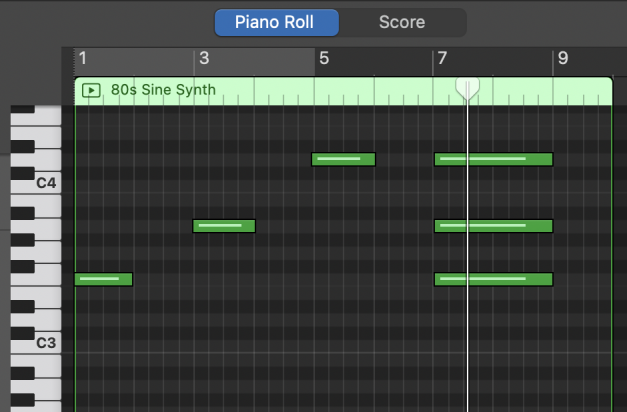
And not only that, after learning the spectrum, we have the ability to separate sounds -for example, when a vegetable dog like me is playing the piano, we may accidentally press the wrong key. If in the waveform map, we may be very very good It is difficult to separate the sound, but if you draw and erase it on the frequency spectrum, it may not be so troublesome.
The picture comes from AudaCity, which is the spectrum of the score above. You can see the frequency distribution corresponding to the note in the spectrum. However, the very long vertical thin line is the sound of the beat.
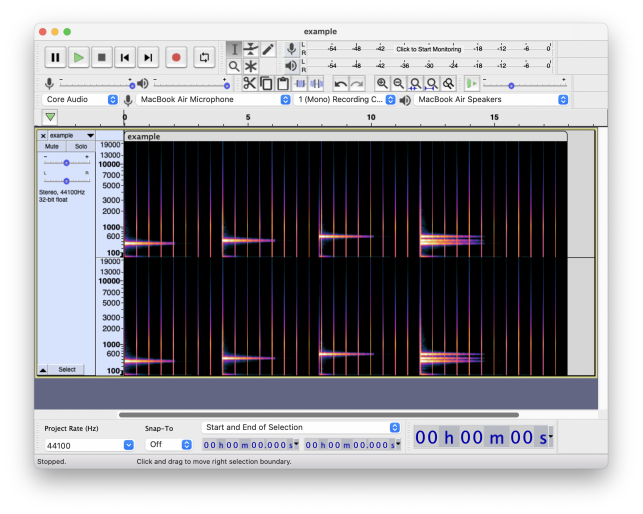
比如在上面的图中,我们就能够像在GarageBand 软件中编写乐谱一样”方便”地处理声音——比如说修改和弦的种类,在GarageBand 软件中,只需要移动一下音符,但在波形图中, It is not very convenient. In the spectrum, we only need to "erase" the sound of the corresponding frequency, and then "draw" a new note with the corresponding frequency.
Observe the results after removing, you can obviously see the brightness of the sound near 600Hz dim, right?
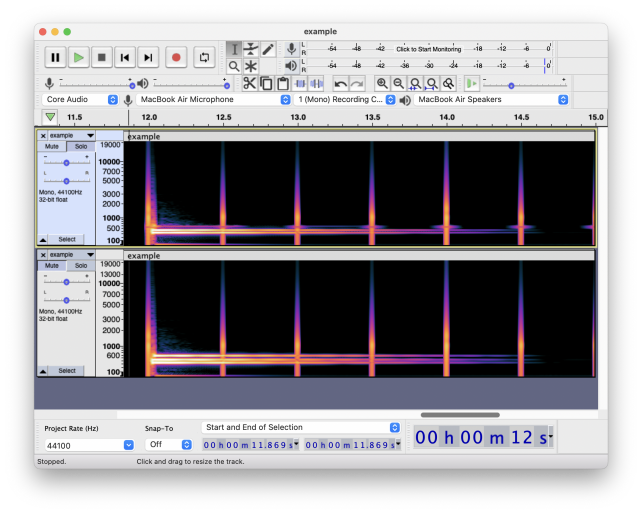
No removal sound:
The sound after removing:
If you listen carefully, you can find that the treble part in the string is gone (because it is filtered out). Generally speaking, the situation that is common to remove a certain frequency sound is often a little low -frequency noise in the environment. By filtering the corresponding noise, some audio noise reduction can be achieved. (Note: This kind of noise reduction is not the same as the current principle of noise reduction headphones.)
For me who is incomplete, I also have the ability to distinguish the sound from music -similar, we can also distinguish other data such as sounds such as sound, that is, it can realize voice recognition recognition. Wait for advanced operations. But this is also the last word. Press no table.
(Note: In fact, it ’s not as good as me. Because I said earlier, the sound is not necessarily pure, so it may not be so simple to delete some complicated sounds from a complicated voice ... but for the target of targeting It is not impossible to deal with waveforms.)
Of course, Fourier's transformation can only be applied in music. As we can see above, the Fourier transformation allows us to see the frequency -the amount of the corresponding sound feature value, so we can grasp the characteristics of the sound to study the problem. Similarly, in addition to the sound signal, we can also expand the Fourier transformation to any type of signal -such as image processing (the processing of light signal, refer to the knowledge), and for example for signal processing. However, such applications may exceed the scope of discussion.
So why not come to practice?
So let's take a look at the spectrum of a sound:
The above picture example comes from the spectrum viewing function of AudaCity. The audio file used comes from audio synthesized by AIKO's sound source in Synthesizer V Basic. The original song of the song seems to be the old man.
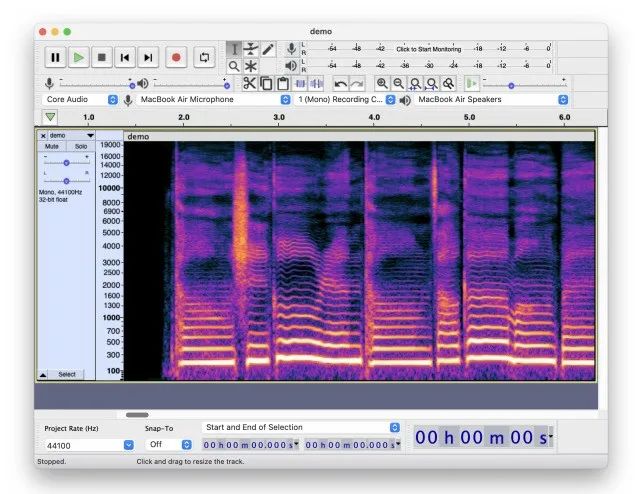
Observe the spectrum diagram in the diagram, the horizontal axis is distributed in time, and the vertical axis is distributed frequency. At a time point, the higher the point of brightness, the more the vibration (intensity, or, the amplitude of the corresponding simplified resonance component), the more big. A simple analogy seems to use brightness to express the strength of pressing the corresponding frequency button, so a song is written on the "spectrum" like this. Just as the corresponding relationship between the piano scores and spectrums seen earlier, why not we can change the idea: a "mapping" between the spectrum and the piano score, and then let the piano sing?
It's so wonderful. Is there any reason not to try this? We only need to change a sound through Fourier to the spectrum, and then correspond to the spectrum and the piano spectrum together, so we can get the piano "" " The song of singing ":
Original sound:
Human voice generated by Synthesizer V Studio Basic.
Use the voice of 80 ’s sine synth in GarageBand:" Say ": (strongly recommend listening to a part of the original song first, then listen to the following sound ...)
The horizontal cut is still vertical, and the one that can be cut is good melon bushi
Now that Fourier has changed this fast knife, I go back to see the original voice, cutting, and phonetic phonetic. Maybe there may be new ideas:

Taking the voice as an example, the word "in" is mixed together, just like the word "Zhi" and the word "Yu" to make a sound at the same time, and this kind of sound is made at the same time, except for the simplicity The perspective can also be regarded as the superposition of the spectrum on the timeline -then isn't this a Viewing angle of Fourier transformation?
Similarly, if you want to make the sound change, you can also use the transformation first, and then move the spectrum, so you sing a high tone. (This is like moving the reference point in the music score when playing the piano. Probably ...)
In other words, when we want to put together the sounds of both ends harmoniously together, when there is no good result of the simple connecting overlord -type operation, we can also use the Fourier to change the part of the audio part of the audio. Mix together to achieve a more "natural" mixing effect.
It can be found that with Fourier transformation, we have the ability to process signals freely. (Actually, Fourier's transformation is far more than that, but this is all later.) With such a powerful processing ability, why not come ...??
Edit: Tibetan idiots, clouds open leaves
- END -
Mu Liangzhu | What is physical and physical culture?
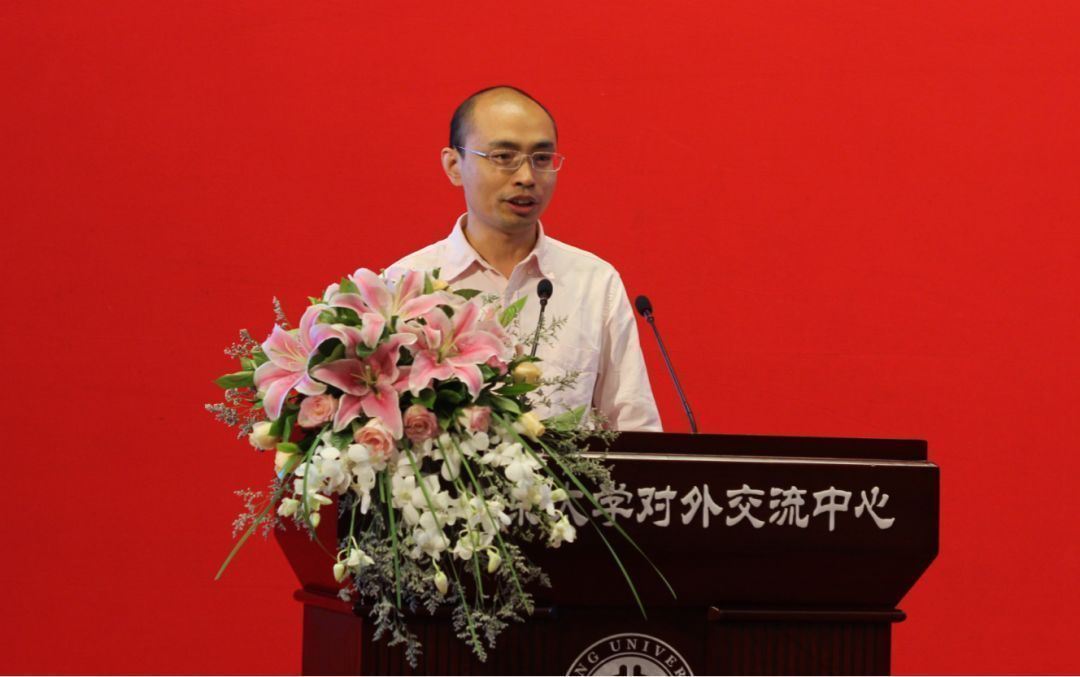
Mu Liangzhu, male, associate professor at the School of Physics at Peking Universi...
[Chaoyong New City Project Red] Another new school opened in September
